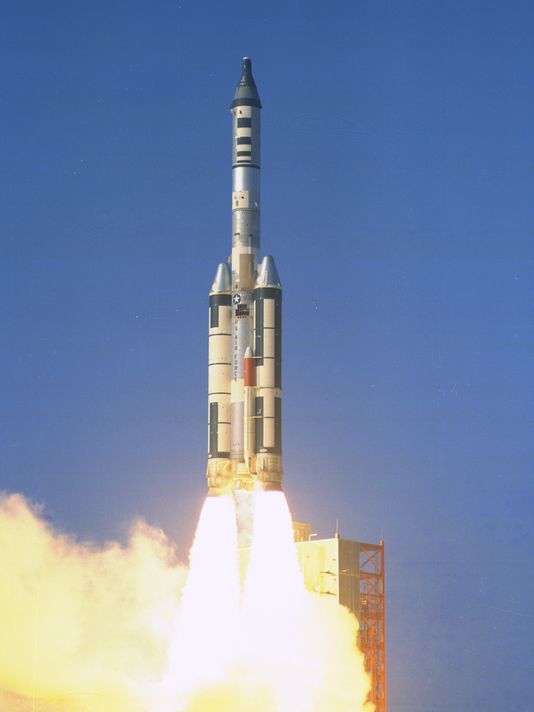.

On Nov. 3, 1966, a Titan IIIC lifted off to test a modified unmanned Gemini capsule as part of the Air Force's Manned Orbiting Laboratory program. The mission including a simulated lab module was the program's only launch.
(Photo: NASA)
-
Watching a Titan IIIC rocket blast off from Cape Canaveral Air Force Station 50 years ago on Thursday, Al Crews thought it was a matter of time before he rode to space on a similar rocket.
He was among the first of 17 astronauts selected for the Air Force’s Manned Orbiting Laboratory program, which on Nov. 3, 1966, launched its first, unmanned test flight from Launch Complex 40.
The 33-minute, suborbital flight would determine if the program's modified NASA Gemini capsule on top of the rocket could survive re-entry with a hatch cut into its heat shield.
The hatch would allow astronauts to tunnel between the capsule and a laboratory module beneath it once they reached orbit.
“I was standing by, because I was very concerned about the heat shield and drilling the hole in it for us to transfer (through),” Crews, now 87, recalled Thursday in front of the capsule displayed at the Air Force Space and Missile Museum. “It worked great, so we were happy.”
“It shocked everybody,” remembered retired Air Force Maj. Norvin “Bud” Evans, 92, of Indialantic, who worked for lead contractor General Electric, of the program's end.
NASA accepted seven MOL flight crew members who were 35 or younger into its own astronaut corps, a group that included Richard Truly, Karol Bobko and Bob Crippen.
Crews, who was older, went on to fly aircraft for NASA but never made it to space.
The Gemini B capsule that launched 50 years ago is a one-of-a-kind artifact on indefinite loan from the Smithsonian Institution’s National Air and Space Museum.
It’s the only Mercury, Gemini or Apollo capsule to fly to space twice, and the only one of the flown capsules with Air Force markings.
“It was unique,” said Evans.
The MOL program intended to fly two-person crews on reconnaissance missions lasting two to four weeks.
The astronauts would help control the spacecraft and keep cameras pointed at targets in the Soviet Union, a capability that unmanned satellites couldn’t yet deliver reliably.
“Everything that was being put out by the Russians was that they were getting way ahead of us, and it wasn’t going to be long that we were going to be bowing to them and doing whatever they told us,” Crews, a retired Air Force colonel, said of the need for orbital reconnaissance at the time. “We were able with the photography to prove that they weren’t telling the truth, and they weren’t any better off than we were.”
The MOL-B test flight in late 1966 occurred less than a decade after Sputnik and just over five years after Alan Shepard became the first American in space, as NASA was ramping up for the Apollo moon program.
Rapid advances in satellite reconnaissance ultimately rendered the military’s manned program unnecessary.
Evans said one of the program's legacies was underwater training that allowed astronauts to simulate working in microgravity, adopted by NASA.
A camera the National Reconnaissance Office developed for manned missions evolved into one later flown on satellites. The NRO last year declassified many records and photos related to the MOL system codenamed “Dorian,” or KH-10.
“At the time we were flying, we couldn’t tell anybody,” said Crews. “Nobody talked about anything until the last year or so.”
For Crews, memories of the Manned Orbiting Laboratory program’s one and only launch to space 50 years ago are tinged with some regret.
“It reminds me of what I didn’t get to do,” he said.
Quelle: Florida Today
